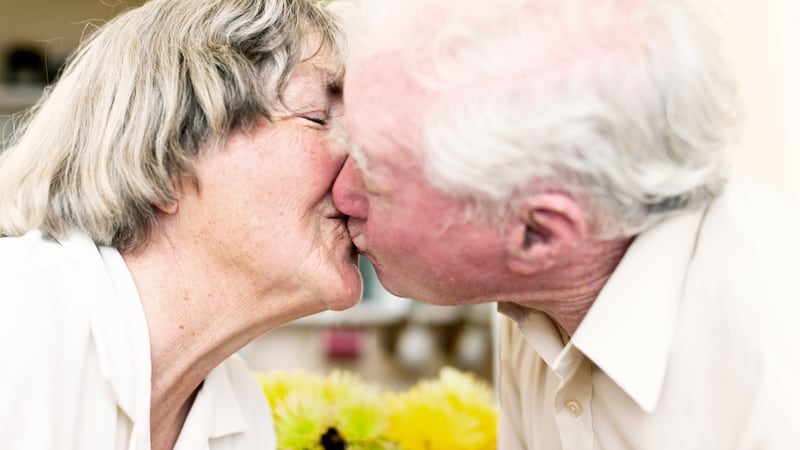No one sums up the opposing attitudes of what constitutes a healthy, normal sex drive better than Woody Allen.
In his 1977 romantic comedy Annie Hall, Alvy Singer (Allen) is asked how often he has sex with his partner, Annie (Diane Keaton). "Hardly ever. Maybe three times a week," he whines. When Annie is separately asked the same question, she too complains: "Constantly. I'd say three times a week."
Not surprisingly, Alvy and Annie don’t last. To some healthcare professionals, he would be adjudged “hypersexual” (having extremely frequent sexual urges or activity) and she “hyposexual” (having a lack or absence of desire for sexual activity). But more on that later.
Simply put, sex drive, or libido, is an individual’s overall sexual drive, or desire for sexual activity. What is less understood is the shifting matrix of biological, psychological and social factors that influence it.
Effects on sex drive
Testosterone is the key hormone controlling sex drive in men and women, but excessive work hours, lack of sleep, depleted energy levels or too much alcohol also have adverse impacts. So too do unresolved conflicts in the relationship or wider family. Then, factors such as stress and personality type can also put a dent in your drive, as well as medical conditions (hypothyroidism, diabetes or depression) and medications (antidepressants and blood pressure treatments).
Still, to be clear, sex drive is not the same as the physical process of sexual arousal; one can hope to have sex with one’s partner and look forward to the prospect, for example, without any arousal at that thought. It’s the intention before any arousal or action. And even if the desire and the arousal are present, personal, moral or religious reasons can put the kibosh on the whole shebang – assuming, of course, one has a consenting, reciprocal partner.
Profoundly sexualised culture
Cultures hugely differ in how early people start having sex, how open they are about discussing it, and how many sexual partners represent the supposed norm. But humankind is hardwired to find sex: if we were not, we’d have died off millennia ago. And simply because we are more open to discussing sex these days doesn’t mean we enjoy or think about sex any more now than our ancestors did.

The turning point for sexuality in the West coincides with the Industrial Revolution, when great swathes of people were pushed together into compact, crowded and culturally mixed cities. This leaned towards the liberalisation of attitudes towards sex, alongside the evolution of contraception.
Then came the pill in the 1960s, and, depending on who you ask, open season has never quite gone away.
"I believe that, on the whole, men and women are largely equal in terms of their sexual ambitions, drive and desires," says Edward Shorter, professor of history of medicine at the University of Toronto and author of Written in the Flesh: A History of Desire.
“Do men have a higher sex drive than women? I’m not sure that is at all true,” he says. “On average, women enjoy sex just as much as men do. They may be a little more prudent in seeking out partners, which has its societal constraints.”
Shorter, who is not a doctor or a healthcare professional, says sex drive is 10 per cent biological and 90 per cent cultural. “We live in a culture that is profoundly sexualised. Sexuality in society used to be a very limited experience, with heterosexual intercourse in the missionary position defining marriages. The sexual repertoire, or palette, was very restricted, but that has been evolving.”
Shorter says he is suspicious of the words “hyposexuality” and “hypersexuality” as sex drive is a personal component that varies with each individual.
A normal, healthy sex drive is simply something that someone is comfortable with
“In many cases, what could be judged hyposexuality is simply a case of an individual not being attracted to their partner anymore,” he says. “You could put that person with another partner and suddenly they’re all good to go. So they’re not hyposexual whatsoever, but were just not keen about sex with that specific partner.
“Just because there is a supposed average number of times that people have sex a week, it doesn’t mean it’s an optimum number. It’s up to each person to find their own optimal number.”
Sexual peak vs sex drive
"A normal, healthy sex drive is simply something that someone is comfortable with," says Stephen Murphy, GP at the Park Clinic in Cabinteely, Dublin.
“What’s interesting is that libido is probably of primary interest to people who still have it, and the thought of losing it is quite frightening. But for people whose libido is low, or who have lost it, apart from the fact they’re upsetting their partner, they’re usually not terribly concerned themselves.”
Whereas men supposedly reach their sexual peak in late adolescence, and women in their late 20s or 30s, it is too simplistic to assume that sexual drive should coincide with sexual peak.
“In other words, don’t equate hormonal peak with sexual prime,” says Murphy. “It’s certainly not something which operates in a straight line. Women can be a lot more affected by location, for example, or the situation, such as how they feel about themselves. Some women can even be at their sexual peak when pregnant. They are far more variable than men, who are much more simplistic, from that point of view.”
A successful sexual relationship is simply one that is compatible
Like Shorter, Murphy is inclined to dismiss averages and norms: some couples are happy with sex once a month, others with six times a week.
“I think for most successful partnerships, one partner should have a higher sex drive than another, but that might vary at different times of the month, the year and, indeed, different decades. I think a successful sexual relationship is simply one that is compatible.”
Murphy concludes that over the past 20 years, the development of drugs used in the treatment of erectile dysfunction (better known as PDE5 inhibitors, of which Viagra was the first and the best known) have been useful, but only for couples who either are sexually active or wish to be, as those drugs do not influence sex drive, just the process of sexual arousal.
Sex without the drive
"The very interesting thing from my point of view as a psychotherapist is that I only work with sex drive when there is a problem," says psychotherapist and Irish Times columnist Trish Murphy.
“That can be when one person’s libido is mismatched with another’s, or when somebody feels they have lost that ability of being sexually attractive to someone else. So, a big drop in sex drive can often appear to me that a person has pulled back from life, from that engagement.”

Low sex drive is estimated to affect about 30 per cent of men and 40 per cent of women at some point in their lives, but how can it be assessed? Murphy says if your sex drive does suddenly drop, you need to look at lifestyle, stress levels, zest for life, physical health and mental, social and emotional wellbeing.
“For example, rising levels of anxiety would definitely play havoc with your levels of attractiveness and attraction towards others. There are lots of things it can indicate, and it’s a very fast indicator: it shows up pretty quickly.
“I would know people who would have thought that they had a low sex drive all their lives, only to discover in mid-life that they had never let rip.
Murphy sees a lot more interest around our sex lives since the introduction of Viagra
“Our belief system, and the containment of it, can really impact us. As always, human beings are more complicated than we’d sometimes wish to think.”
Murphy sees a lot more interest and expectations in the dynamic around our sex lives since the introduction of Viagra in the late 1990s. “A lot of couples had given up until Viagra came along, and then the issue reawakened. So, I think the landscape around that has changed a lot of over the past 20 years or so.”
Pleasing the partner
Lastly, it should be pointed out that sex life and sex drive should not be confused: many individuals consent to sex without necessarily wanting it or enjoying it, often to please their partner.
“Yes, but that’s not always negative, or it doesn’t have to be. Often that is seen as a gift, or a demonstration of love, even if they don’t actually feel the drive,” says Murphy. “But I also think there is a lot more couples can do about that than they’re aware, rather than just thinking, for example, oh it’s a Saturday morning, we must do it.
“If they discussed the topic, there is probably a lot more they could do to make sex more desirable and interesting.”

PANEL: SEX LIVES OF THE IRISH – HOW MUCH IS ENOUGH?
The Irish Times sex survey in 2015 shed some fascinating light into the sex lives of more than 12,000 people in Ireland. Here are some of the results:
33 per cent said their sex drives were “about the same” as their partners. However, 45 per cent said their sex drive was higher than their partner’s, while 22 per cent said their partner’s was higher than their own.
44 per cent of all sexually active participants said they have sex at least once a week, including 14 per cent who have sex three times or more each week. For couples who have been together more than one year, the average is once a week.
61 per cent of respondents said they have had fewer than 11 sexual partners in their lifetime.
The most sexually active age group is the 25-34 category.
40 per cent of heterosexual men reported they have had 11 or more partners, compared with 32 per cent of heterosexual women.
Heterosexual men are more likely to have had one-night stands (73%) compared with 66% of heterosexual women.
PANEL: WHY 'SEX IS NEVER INEVITABLE'
Carlow-born sex columnist Suzi Godson moved to London aged 18. Author of The Body Bible, Sex Counsel and the award-winning The Sex Book, she has written a weekly sex and relationships column for the Times newspaper in the UK for the past 10 years.
“In reality, if we lived in a world where men and women possessed equal appetites for sex, where would the sexual tension be? Human sexuality seems to be based on the principle of opposing polarities and the male and female coupling appear to be a biological illustration of positive and negative electromagnetic interaction.
“Our differing sexual drives are matched in turn by our differently functioning, but complementary, reproductive systems. If we accept that our biology is not by accident but design, then it makes sense to accept our distinctive libidos as a part of that. Although men might argue to the contrary, if men and women had exactly the same drives, sex would almost certainly lose some of its appeal.”
Godson cites a 1998 research paper by KC Berridge and TE Robinson in the US. The professors determined that dopamine, the neurotransmitter which motivates us to seek sex, is stimulated by unpredictability. As well, functional magnetic resonance imaging scans have demonstrated that the anticipation of a reward generates more neural activity than the actual reward itself.
“As such, as soon as something, anything, that we enjoy becomes both accessible and predictable, we are inclined to lose interest in it,” Godson says. “The gap between male and female libidos means that sex is never inevitable and this creates a variable schedule of reinforcement where reward cannot be presumed.”















